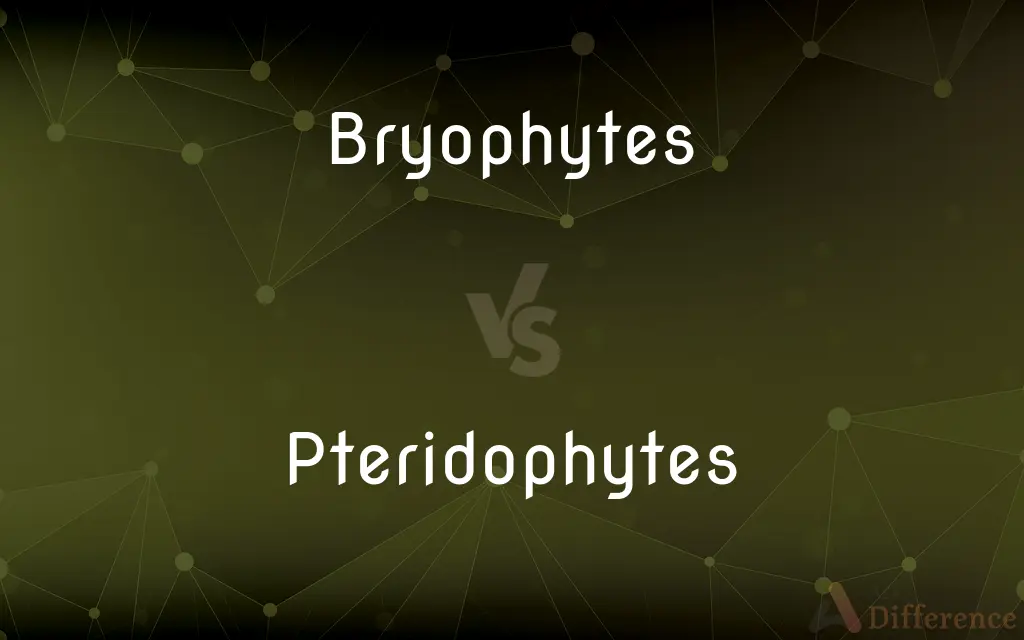Bryophytes vs. Pteridophytes — What's the Difference?
By Tayyaba Rehman — Published on January 7, 2024
Bryophytes are non-vascular, simple plants like mosses; Pteridophytes are vascular, more complex plants like ferns.

Difference Between Bryophytes and Pteridophytes
Table of Contents
ADVERTISEMENT
Key Differences
Bryophytes represent an early stage in land plant evolution, lacking true roots, stems, and leaves. Pteridophytes are more evolved, possessing these structures along with vascular tissues for water and nutrient transport. Both groups are important for studying plant evolution, but pteridophytes show a greater complexity in structure.
While bryophytes thrive in moist environments due to their dependence on water for reproduction, pteridophytes can inhabit a broader range of habitats. This adaptability in pteridophytes stems from their advanced vascular systems, which bryophytes lack, limiting their size and ecological range.
The life cycle of bryophytes is dominated by the gametophyte stage, which is the green, photosynthetic part we commonly see. In contrast, pteridophytes have a dominant sporophyte stage, typically larger and more conspicuous, reflecting their more advanced life cycle.
Bryophytes reproduce via spores produced in capsules, which require water for sperm motility. Pteridophytes also reproduce by spores, but their sperm are not necessarily water-dependent due to the presence of vascular tissues that aid in supporting a more terrestrial lifestyle.
Bryophytes do not have true vascular tissue, which limits their size and growth habitats to places where water is abundant. Pteridophytes, however, have vascular tissues like xylem and phloem, allowing them to grow larger and inhabit diverse terrestrial environments.
ADVERTISEMENT
Comparison Chart
Vascular System
Lack vascular tissues.
Have a well-developed vascular system.
Habitat
Mostly moist and shaded areas.
Varied habitats, including dry conditions.
Structural Complexity
Simple with no true roots, stems, or leaves.
Complex with true roots, stems, and leaves.
Dominant Life Cycle Stage
Gametophyte is dominant.
Sporophyte is dominant.
Dependency on Water for Reproduction
High; sperm require water to reach eggs.
Less; can reproduce in drier conditions.
Size
Generally small due to lack of support from vascular tissues.
Larger, with vascular tissues providing support.
Compare with Definitions
Bryophytes
They exhibit a simple plant structure without true roots or leaves.
The bryophytes covering the forest floor are soft and spongy.
Pteridophytes
They have a dominant sporophyte stage in their lifecycle.
Pteridophytes display their leafy fronds during the sporophyte phase.
Bryophytes
Bryophytes are non-vascular plants including mosses, liverworts, and hornworts.
Mosses, a type of bryophyte, commonly grow on damp rocks.
Pteridophytes
Pteridophytes are vascular plants that include ferns and their relatives.
The shaded undergrowth was dotted with various pteridophytes.
Bryophytes
Bryophytes are important ecological indicators and contribute to soil formation.
The presence of certain bryophytes can indicate soil and air quality.
Pteridophytes
Pteridophytes are known for their large fronds and complex leaves.
The large fronds of pteridophytes unfurled after the rain.
Bryophytes
Bryophytes require water for sexual reproduction.
Bryophytes flourish near streams and rivers due to their reproductive needs.
Pteridophytes
These plants reproduce by releasing spores into the air.
In the forest, pteridophytes dispersed spores from their underside.
Bryophytes
They have a life cycle dominated by the gametophyte stage.
In bryophytes, the green tissue that photosynthesizes is the gametophyte.
Pteridophytes
Pteridophytes have well-developed root systems and vascular tissues.
The pteridophytes anchor firmly into the soil with their robust roots.
Bryophytes
Any of numerous photosynthetic, chiefly terrestrial, nonvascular plants that reproduce by spores, including the mosses, liverworts, and hornworts. These three groups together formerly made up the division Bryophyta, which is now restricted to the mosses alone.
Pteridophytes
Any of numerous vascular plants that reproduce by means of spores rather than seeds, including the ferns and related plants such as horsetails, and sometimes the club mosses.
Bryophytes
Plural of bryophyte
Pteridophytes
Plural of pteridophyte
Common Curiosities
Where do bryophytes commonly live?
Bryophytes are often found in moist, shaded environments.
What distinguishes pteridophytes?
Pteridophytes are vascular plants with more complex structures like ferns.
How do pteridophytes contribute to their ecosystem?
Pteridophytes can form dense undergrowth that supports wildlife and prevents erosion.
Can bryophytes grow tall?
No, bryophytes typically remain small due to the lack of vascular tissue.
Do pteridophytes have seeds?
No, pteridophytes reproduce through spores, not seeds.
What are bryophytes?
Bryophytes are non-vascular, primitive plants like mosses.
Are bryophytes good indicators of ecological conditions?
Yes, bryophytes are sensitive to environmental changes and can indicate ecological conditions.
What is the significance of vascular tissue in pteridophytes?
Vascular tissue allows pteridophytes to transport nutrients and grow larger.
What kind of habitats can pteridophytes inhabit?
Pteridophytes can live in a variety of habitats, including dry areas.
Are bryophytes important to the environment?
Yes, bryophytes help in soil formation and water retention.
What is the main reproductive method of bryophytes?
Bryophytes primarily reproduce through spores that need water.
What kind of roots do pteridophytes have?
Pteridophytes have true roots that absorb water and nutrients from the soil.
How do pteridophytes reproduce?
Pteridophytes reproduce via spores and do not require water for fertilization.
Do bryophytes have true leaves?
No, bryophytes have structures that resemble leaves but are not true leaves.
Can both bryophytes and pteridophytes be used in landscaping?
Yes, both can be used, with bryophytes suited for moist areas and pteridophytes for a range of conditions.
Share Your Discovery

Previous Comparison
Chime Bank vs. Ally Bank
Next Comparison
Eastern Coastal Plains vs. Western Coastal PlainsAuthor Spotlight
Written by
Tayyaba RehmanTayyaba Rehman is a distinguished writer, currently serving as a primary contributor to askdifference.com. As a researcher in semantics and etymology, Tayyaba's passion for the complexity of languages and their distinctions has found a perfect home on the platform. Tayyaba delves into the intricacies of language, distinguishing between commonly confused words and phrases, thereby providing clarity for readers worldwide.
















































